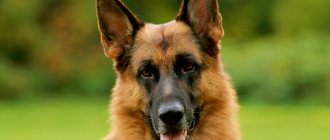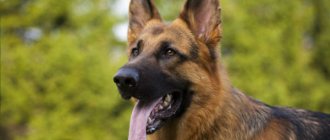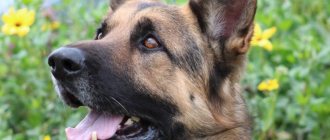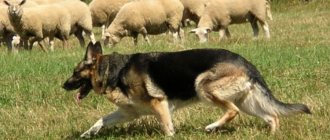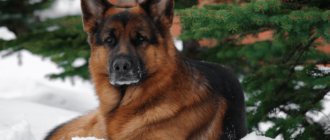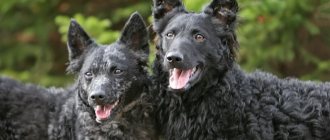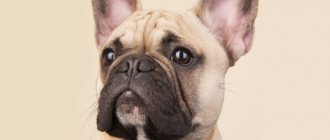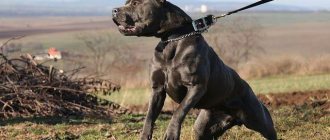Description
The German Shepherd is one of the most famous dogs in the world. This breed is respected for its rich history and great cultural influence in various world societies.
— Advertising —
According to the American Kennel Club, the animal ranks first on the list of “best police, security and military dogs.”
The first recognized specimens appeared in Germany in the late 1800s, the result of deliberate crossbreeding between farm dogs and herding dogs. Caring for this active and alert breed requires early socialization, obedience training, and attention to general health concerns.
Hormonal disorders
Hormonal imbalances are primarily divided by the reason why they occur:
- Primary. They appear due to a genetic factor and develop in puppyhood.
- Secondary. They arise as a result of any disease: cancer, infection, systemic inflammatory or autoimmune pathology.
Based on the condition of the coat and skin, we can conclude the type of hormonal disorder:
- With hypothyroidism, hair grows in clumps on the neck and chest, after which alopecia spreads to the back and limbs. In addition, there is lethargy and decline in immunity.
- Decrease in estrogen levels. At the same time, hair growth decreases, it becomes thin and brittle. It is observed in bitches after sterilization.
- Excess estrogen. It can develop in Caucasian Shepherd dogs of both sexes. Hair falls out symmetrically from the sides. In females the vulva swells, in males the foreskin swells.
- Diabetes insipidus. Baldness is distributed evenly throughout the body, with strong thirst, polyuria, and clear urine.
- Decreased concentration of sex hormones. Hair grows on the ears, in the groin area, tail, legs, and neck. An important symptom is atrophy of the genital organs.
Appearance
What does the animal look like? Breed standard.
The head is wedge-shaped, with a long face. Nose is black. The eyes are medium-sized, almond-shaped, set slightly obliquely, not protruding. The color is dark. The ears are straight, medium-sized, parallel, cone-shaped. Powerful mouth with a scissor bite. The upper incisors closely overlap the lower ones. The teeth are strong, light, there are 42 of them.
— Advertising —
The neck is strong, muscular, neat and relatively long. It is proportional in size to the head, without loose folds of skin. The back is straight and well developed. The chest is moderately wide and deep. Forelegs: shoulder blades long, sloping, placed flat. When viewed from all sides, the legs are straight. The hind legs are parallel, with muscular thighs. The tail should reach at least to the hock joint.
Males are usually larger than females. The normal weight of individuals is 22-40 kg, height is 55-65 cm.
The breed has a thick double coat of coat that protects from the elements. The outer coat is harsh, while the undercoat is fluffy, soft and dense. The head, inner ear and forehead, as well as the legs and paws are covered with short hairs. The neck comes with longer and thicker hairs.
Most common colors:
- Black.
- Black and red.
- Sobolinaya.
- Brown.
- Rare: gray color.
Black and zoned are special names for popular coat colors.
Skin parasites
The most common cause is the scabies mite. This parasite lives in the skin of an animal and gnaws passages in it. Because of it, the dog experiences severe itching and constantly combs its fur. The tick often affects the area around the ears, skin folds, neck, and abdomen. Redness with scratch marks is found on the skin.
Pros and cons of a dog
You should learn about the pros and cons of the breed before you get such an energetic friend. Characteristics of advantages:
- They make excellent show pets.
- Individuals have a long life expectancy.
- Shepherds have a lot of energy.
- Animals have a highly developed instinct to protect their owners.
- They protect their home perfectly.
- Dogs are smart and easy to train.
- Pets are adapted to any weather conditions.
- They have an attractive appearance.
- German Shepherds require minimal grooming and bathing.
- Dogs are much healthier than other dogs.
- Individuals love to swim.
- There is a lot of information about the breed that is available to all owners.
Characteristics of minuses:
- The disadvantage is that the animals shed a lot. Especially hard twice a year.
- They are large in size and have a lot of energy.
- Dogs need a lot of exercise.
- Sometimes individuals bark a lot.
- It can be difficult to find a reputable breeder.
- Dogs should not be left alone for too long.
- You need to devote a lot of time to them.
- Sometimes dogs can only become attached to one person.
- You need to be their leader.
- Shepherds can be aggressive.
Advantages and Disadvantages
Successful selection makes it possible to achieve almost bald skin due to the following important factors:
- Genetic predisposition.
- Society's demands.
- Mutational changes.
- Fashion for a specific breed.
If we talk about the advantages of such creatures, we can highlight the following:
- The absence of fur as a strong allergen for humans, which allows almost anyone to have such a creature.
- They tolerate the hot season without problems.
- Minimal care.
- There is no unpleasant smell, which pleases many.
- There are almost no costs for combing and cutting in special salons.
It is also impossible not to note the disadvantages of these creatures:
- Greater susceptibility to various skin diseases.
- In some situations, special education is required to develop a character “to suit the master.”
- The need to comply with conditions for walking in too cold seasons.
History of the origin of the breed
The German Shepherd is a relatively new breed. Its origin dates back to 1899. The dog owes its existence to Max von Stephanitz. The man was a German cavalry captain and wanted to create an unrivaled appearance.
Centuries before von Stephanitz, farmers in Germany, as in the rest of Europe, adopted dogs to protect their flocks. Some individuals were excellent in skill and skill. Therefore, many shepherds and farmers tried to breed dogs. However, as von Stephanitz noted, no one has turned the region's herding dogs into a distinct species.
In 1898, von Stephanitz retired from military service and began his "second career". This was his passion - the man experimented with breeding dogs, with the goal of creating the ideal German shepherd breed. Stephanitz studied breeding methods and traveled throughout Germany, visiting and observing animal shows.
He saw many different herding animals that were either athletic or intelligent and trainable. However, he did not see a breed that embodied all these traits at once.
In 1899, at a dog show, a wild wolf dog caught his eye. He immediately bought the animal, named Hector Linksrine. Von Stephanitz was so impressed by the dog's powerful physique and intelligence that he created a society to breed this special breed.
On the one hand, the man wanted his appearance to be that of a shepherd. But on the other hand, he knew that Germany was becoming an increasingly industrialized country. The former captain came to the conclusion that his animal will remain a working dog, but will be implemented in the fields of the police and army.
Taking advantage of his military connections, von Stephanitz convinced the German government to use this type in the army. The Sheepdog served as a Red Cross dog, courier, rescue dog, guard, carrier and sentry during World War I.
Although the animal came to the United States before the war, it was only at this time that military personnel noted the dog's courage and intelligence.
One of these dogs was a five-day-old puppy that an American corporal from Los Angeles rescued from a bombed kennel in France. The corporal took the baby home, trained him and turned him into one of Hollywood's most recognizable four-legged stars. The pet's name was Rin Tin Tin. He appeared in 26 films and helped popularize the breed in America.
While people were impressed with the dog, they were not as happy with the dog's German roots and name. During the war, all things of German origin were subject to stigmatization - social labels. Therefore, in 1917, the American Kennel Club changed the name of the breed to “Sheepdog.” In England, the animal was renamed the "Alsatian wolf dog".
Von Stephanitz remained closely involved with the development of the species. In 1922, he became alarmed by certain traits that dogs exhibited. These included a bad temperament and a tendency to tooth decay. He developed a strict quality control system. Individuals had to pass numerous tests for intelligence, temperament, athleticism and health before being bred.
German Shepherds of English and German origin began to diverge greatly in standards after World War II. Therefore, many subspecies appeared. American animal breeding was also largely unregulated. In the United States, dogs were primarily bred for showing. Therefore, breeders paid more attention to the appearance and gait of individuals.
The American Kennel Club reverted to using the original species name only in 1931. It took the British Kennel Club until 1977 to do the same.
Possible causes of hair loss in dogs
There are many factors that can provoke active hair loss in an animal. All of them can be divided into two large blocks: hormonal and non-hormonal.
In order to determine the first causes, dog owners should take a closer look at the bald areas: if hair falls out on symmetrical areas of the body, the cause of hair loss most likely lies in hormonal disorders. But if the affected areas with missing hair are located chaotically, the cause of the pathology is absolutely not related to hormones.
Kinds
There are a sufficient number of varieties of shepherd dogs relative to breeding lines:
- German: working lines.
- German: exhibition lines.
- German: East German line.
- Czech/Slovak.
- American.
- Old American.
- Old type.
- English.
- Swiss (mountain).
- Belarusian.
- Caucasian.
- Russian.
- Chinese.
- Central Asian.
And:
- Panda.
- Shepherd dogs without a mask.
- Shiloh Sheepdogs.
- Royal Shepherd.
- Old style German Shepherd.
- Kunming Shepherd.
- Sarlouz Wulfhound.
- Utonogan.
- American tundra.
- Dwarf.
- Gypsy.
- Black German Shepherd.
Photos of different types are presented below.
Longhair
The long-haired type (long-haired) is not considered a separate breed. The recessive gene for long hair is present in all lines and subspecies of individuals. It may appear unexpectedly. Sometimes a slight lengthening of the hairs is possible, and the appearance of very long hair is possible. In such cases, caring for your pet will be more difficult.
The photo is presented below.
Symptoms
There is no single clinical picture for alopecia, since each type has its own set of manifestations. But they can be grouped:
- Baldness caused by allergies or demodicosis is characterized by itching, itching, and redness of the skin.
- With folliculitis, flea dermatitis, erythema, papules with serous fluid are formed. When the dog opens them, the pustules turn into ulcers.
- The fungal, viral and bacterial nature of baldness is accompanied by vomiting, loose stools and lethargy.
- With ringworm, you can find a rash, peeling, cracks, and crust formation on your pet's skin at the sites of damage.
- In addition to baldness, folliculitis is accompanied by increased body temperature, itching, the formation of pustules, and redness of diseased areas of the skin.
Hormonal causes of alopecia are asymptomatic, sometimes hyperpigmentation appears in the bald spot area. It is the multiplicity of manifestations, as well as their different nature, that makes diagnosis difficult. Therefore, to confirm the diagnosis, you need to conduct a comprehensive examination of your pet.
Maintenance and care
- This is a double coated breed. Therefore, it needs to be looked after regularly. If your cat is young and active, brush and comb its coat every few days. During spring and summer molts, this will have to be done more often.
- Basically, this is a pure breed that does not require frequent washing. Bathe your pet once a month because more frequent baths can cause his skin to become dry and irritated.
- Check your teeth regularly and use oral cleaners.
- Check your toenails about once a week. Get them trimmed at home or at a groomer.
- Clean your pet's ears at least once a week.
- Walk your pet 1 or 2 times a day if the dog has enough space for indoor activities. Namely, he lives in a house with a large yard. The walk should last 30 minutes. If the dog lives in an apartment, then he may need more time for outdoor activities.
- Pets that are confined to small spaces may destroy objects in the home.
- If you live in a private house, make a wooden kennel for your friend outside. The drawing can be found on the Internet.
- Take your pet to the veterinarian periodically. Do this about once a year. The veterinarian will check the general condition of the animal, prescribe vaccinations, and examine the dog for common and genetic diseases.
Owner reviews
kaplya
Advantages:
Not a bad watchman, versatile, good friend, gets along well with people
Flaws:
Barks a lot for no reason, lacks guard qualities
Still, the fact that the Germans are herding dogs makes itself felt. The German Shepherd is not as good a watchdog as the Rottweiler or Doberman, for example, which were bred specifically to work against humans, but German Shepherds make up for this shortcoming with their versatility. Germans get along well with people, are obedient, and very smart. But of course training is required. The breed is quite easy to train. As a rule, Germans need to be poisoned and taught to bite. Don’t think that your dog knows and can do everything from the start. She certainly doesn't know how to bite properly. If you train a German, you will not have a more sociable, obedient dog.
The German is a faithful servant. There is nothing more tragic than the sight of a German on a chain or in an enclosure. To use your dog's full potential, keep him freely patrolling the area. The downside is increased barking and empty talk. Anyone who has been to a German monobreed show will understand what I mean: terrible barking and nervousness. and if kept in an apartment, then wool is everywhere.
When we go to dog sporting events, 90 percent of the participants are German Shepherds. If you need a watchman, adequate, smart, get a German.
Grooming is quite simple. Brush him periodically (usually we do this during the molting period and that’s it) and I advise you to give him at least a spoonful of sunflower oil a day. Then six will be shiny, silky. But no vitamins will make the coat shiny and the face smiling if the dog does not have a sensitive, understanding owner.
General impression:
Not a bad breed for guarding, versatile
Sogetezy
Advantages:
Cool breed, always active and obedient.
Flaws:
Those who love will not find any cons
I am a fan of this breed of dog, he is a very smart and very friendly dog, of course only for his owners, because in addition to everything he is also a guard, he simply should not be friendly to everyone, I think so) My dog is already 4 years old, during this time we have experienced a lot, illness, joy, children) that is, puppies.
Not a day goes by without my beloved 4-legged pet, he and I go to nature, fishing and just for a ride in the car)
Even as a puppy, I didn’t take him to the trainer very often because I think that these people kill their individuality, and the dog turns into a greedy dog or even some kind of robot that can only communicate with commands, very rarely licks a hand or chases away an enemy cat)), so he I was somewhere in classes 5-7, and we decided to give up this matter, so to speak, we listened and left. But he can’t be a dog that is not at all well-mannered and doesn’t know commands) and I approached this matter responsibly, since this breed is very trainable and you have to be generally lazy so as not to teach your dog all the basic commands.
We have successfully learned the commands “Voice” “place” “stranger” “sit” “give me a paw” “look, maybe someone is walking there”) this command is given at any time of the day and he rushes with all his paws to the gate and listens carefully to who is walking through on the other side of the fence, and if he hears strangers, it’s just difficult to calm him down) he’s angry like a dragon)) and other commands, I would say that they’re not commands, but he just understands, like, human language, and does what they say, for example, come in, leave, don’t touch, and etc.)
But I, as a person who keeps this breed, will tell you responsibly, if you live in an apartment, you don’t need such a dog, they constantly need to run, and in no case sit idle for a long time, they develop fat in the heart and in the body in general and then they get very sick, become very weak and susceptible to many diseases, they need oxygen and a place where they can run, bark, dig something, etc. Of course, a private house is ideal for this.
And of course they have good appetites, but if they don’t eat enough, then something is probably wrong...
I know from our experience that if we run for a long time after a ball, then a big pot of porridge with meat and vegetables is very little for us) You also need to keep this dog wisely and prepare for normal, I would even say inflated material costs, and then your dog will delight you and protect the house and property for life.
It’s a pity that they only live on average 10-11 years.
General impression:
A faithful friend, a guard, and just a positive dog)
Honestly
Advantages:
I was smart enough not to crap after six months
Flaws:
Uneven performance, hysteria, eternal whining, desire to do nothing. Not the smartest breed! If you want challenges, I recommend it.
Ask experienced dog handlers and they will tell you that the breed is no longer the same. And I’m not talking about the lame standards for females and males in today’s ring. I'm talking about working qualities. I suffered for six years. The bitch is hysterical (and I still know a couple of them), she had difficulty socializing - she still attacks small dogs. He needs the selective presence of dogs on the site; he doesn’t accept everyone, he works unevenly, and is much inferior to the Belgian Shepherd. Although it’s certainly more impressive in appearance, what’s the point? Lazy, unintelligent, inferior in intelligence to the same Rottweilers and boxers. A shame. She didn’t allow them to reproduce; it’s a crime to produce morons. I'm disappointed in the breed, I won't buy it again, it's not a breed, it's a travesty.
General impression:
The breed is dying out
Anonymous
Not for an apartment! You stink and people will shy away from you - that’s it. Everything will be covered in wool, you will find it even in the sugar bowl, it is impossible to remove it, it appears again instantly. In addition, you will ruin the dog’s psyche by keeping him in a one-room apartment. The German needs a job! Without it, the dog languishes, gets sick, breaks down mentally, hence the behavioral problems.
Sunshine lady
My most favorite dogs! I love Germans, if I didn’t live in an apartment, I would definitely get a dog like this! My father has a German dog, Greta, a very affectionate, kind and playful dog. But he really doesn’t like strangers! The hardest part of grooming for me is combing! I had to do this often and for a long time. Her father never gave her raw bones; he bought tails and breasts at the pet store, and she especially adores chicken feet. These dogs are very smart and easy to train.
Video
Nutrition
It is also important to understand how you will feed your pet.
Dogs have a more difficult time digesting food due to the fact that they have a relatively small intestine. Therefore, animals need a balanced diet that will help avoid allergies, hip dysplasia or bloating.
Adult pets need to receive protein, fats, carbohydrates, fiber, vitamins and minerals. Quality dog food always contains the right balance of each nutrient.
What are the above substances needed for?
- Protein: for the growth and development of the body as a whole.
- Carbohydrates: to maintain energy.
- Fats: for energy production.
- Vitamins and minerals: for general health.
- Fatty acids: for a shiny and beautiful coat.
Active individuals need to receive 1800-2400 calories per day. For older people or less active people, 1300-1600 calories per day is enough.
Choosing the right food is not difficult. The first ingredient on the label should be a source of protein. Chicken, beef and fish are excellent choices. But there are individuals who are allergic to one of these three protein sources. Therefore, always read the labels on the package before purchasing.
The list of the most common food allergies in the breed also includes corn and wheat. Therefore, it is better to avoid feeds containing these grains. Food dyes, preservatives and other chemicals can also cause allergies. Many German Shepherds are allergic to dairy products, eggs, and soy.
If you notice that your pet has intestinal problems or is constantly itching, try changing the brand of food. Choose one that has completely different ingredients as the main source of proteins and carbohydrates.
What cereals can you give your pet?
Give the individuals rice, buckwheat, millet, oats, millet. Do not feed your pet a mixture of corn and wheat. Firstly, dogs may be allergic to these components. Individuals are also at high risk of stomach distension caused by these grains. Bloat can be fatal.
If your dog refuses food for a day or more, contact your veterinarian immediately.
Feed
Which food is better to give to an animal: dry food or wet food?
There are many good dry and wet foods available. Many people find it difficult to choose between these two types of products. Wet food sometimes contains raw pieces of meat or other foods and may seem like a better option.
Dry food is generally a decent choice if your German is young. Dry foods have some benefits for dental health. Its texture helps remove and prevent plaque formation, especially in youth. Chewing dry food helps build strong jaw bones and muscles. In general, dry food is more convenient.
An older animal will have difficulty chewing due to missing teeth or problems with them.
It is possible to combine dry and wet food.
Many owners feed their dogs raw food. They claim that raw meat and vegetables are what a dog would eat if it lived in the wild. However, dogs that live in the wild rarely live more than four or five years. Also, domesticated animals are quite different from wolves and wild dogs, so feeding them exactly the same food is not always acceptable.
Allergy
Often, ear sores appear as a sign of a full-blown allergy caused by an unsuitable food product, care product or medication. Even a previously unused vaccine can provoke the onset of an allergic reaction.
Identifying the problem is quite simple:
- Redness occurs on both the inside and outside of the ear.
- Constant itching forces the dog to inflict unnecessary wounds on itself.
- General swelling appears.
- Discharge from the eyes.
If you are absolutely sure that the cause of your poor health is an allergic reaction, then you can get rid of it with the help of antihistamines and by eliminating contact with the thing that causes such symptoms.
Girl
You can tell a girl from a boy by height and weight. Knots are usually smaller. The standard weight of a female is 22-32 kg, height - 55-60 cm.
Some dog lovers claim that there are no differences in temperament and behavior between males and females. But there are still some nuances.
Women are more sensitive than men. Their smaller size, greater agility and temperament mean they are easier to train.
The female dog is sweeter and more tolerant of strangers and children.
A girl comes into heat twice a year if she is not spayed. It usually lasts two or three weeks. During this time, her secretions will attract male dogs from many kilometers away. This can make walking difficult.
What to do if your dog's ears start to go bald?
Selecting effective treatment is only possible if the correct diagnosis is established. Taking any measures on your own is pointless and even dangerous. You can try to treat a symptom without eliminating its true cause. Meanwhile, the real disease will progress. The dog needs to be shown to a veterinarian. The specialist will prescribe a diagnosis. Primary analyzes include:
General and biochemical blood test.- Analysis of urine.
- Biochemical analysis of skin scrapings from the affected area.
- Biopsy (if necessary).
- Phototrichogram.
- Wood's lamp glow.
After the diagnosis is established, the animal is prescribed therapy on an inpatient or outpatient basis. Most diseases respond well to treatment. And the sooner the cause is identified, the sooner the pet will recover.
Boy
The average weight of a male is 30-40 kg, height is 60-65 cm.
The male is taller, larger and heavier than the female. It has a large head and a wider body.
Males love to dominate, they are proud, while females are more affectionate and gentle. Males are also more territorial towards their home, yard, property and owners.
He prefers to communicate with his authority figure, who spends the most time with him. Despite the fact that he loves every member of his family.
Because males like to dominate, their training can be more challenging.
Boys will need more food than girls due to their larger size.
Monument to a shepherd dog in Tolyatti
On the outskirts of the city of Tolyatti there is a monument to a shepherd dog. A faithful dog lived on this street for 7 years, waiting for his owners. According to legend, its owners were newlyweds who were returning from their honeymoon. Their cherry nine collided head-on with an oncoming car. The owners died, but the dog remained alive. Every day, again and again, he came to the place where he last saw the owners alive. Seeing the cherry nine, the dog happily rushed towards it, thinking that the owner had returned.
Many residents tried to shelter the dirty and tattered dog, but he ran away again and again and returned to the Southern Highway. Only in 2002 did the dog leave his post: sensing the approach of death, she went into the forest to die. Residents of the city, who sincerely fell in love with the faithful dog, installed a shield on the side of the road with a soul-touching inscription: “To the dog who taught us love and devotion . The shield broke several times due to gusts of wind and the actions of vandals. In 2003, the shield was removed, and in its place a “Monument of Devotion” was erected in honor of the faithful dog.
Nicknames
For boy
Modern names for boys:
- Alex.
- Apollo.
- Atlas.
- Boris.
- Brunson.
- Bruno.
- Captain.
- Cain.
- Duke.
- Dino.
- Ernie.
- Fletch.
- Fido.
- Freddie.
- Goliath.
- Hercules.
- Harley.
- Larry.
- Maximus.
- Rex.
- Newton.
- Lobster.
- Owen.
- Omega.
- Polo.
- Rudy.
For girl
Popular nicknames for girls:
- Angel.
- Alian.
- Aba.
- Abigail.
- Annabelle.
- Athena.
- Alexandra.
- Anna.
- Ava.
- Blair.
- Boni.
- Chloe.
- Cassie.
- Cleopatra.
- Erika.
- Elsa.
- Venus.
- Gloria.
- Hayley
- Isabel.
- Lucy.
- Milli.
- Mia.
- Maxi.
- Rose.
- Rachel.
Otodectosis
Ear mite damage is one of the most common causes of problems in domestic purebred dogs, since they have a much weaker immune system that does not protect against parasites. Even an animal that is not outdoors but comes into contact with other animals can become infected.
Almost all stray dogs are affected by this parasite.
Microscopic insects, falling on the inner surface of the auricle, bite under the skin and gnaw passages in it, feeding on particles of the epidermis and bloody secretions. Because of this, crusts and sores begin to form on the tips of the ears, and brown scabs appear, which are waste products of mites.
If the onset of infection is not noticed in time, then over time it will lead to the development of otitis media, and in particularly advanced cases it can provoke replenishment of the brain. Therefore, when you see the first mild signs of infection, you need to start taking action.
Additional signs of ticks are:
- Constant itching, disturbing the dog and forcing it to scratch the sore spot on all possible surfaces.
- Unpleasant smell.
- The appearance of sores and a gradual increase in their number.
- Too much dirt in the affected area.
When you contact the clinic, the doctor will take a scraping of the affected area of the skin and conduct the necessary examination, and then prescribe antiparasitic drugs and ointments.
If there is no opportunity to seek help at the moment, you can stop the proliferation of parasites by treating the sores with hydrogen peroxide, moving the pet to more comfortable conditions and increasing the diet.
Breeding
In Germany there are two principles for breeding the breed: “high” (show) and “working” (sports).
There are several criteria by which individuals are allowed to breed. These include:
- Pedigree.
- Exterior of the dog.
- Psyche and performance.
- The quality of existing offspring.
More demands are placed on boys than on girls.
The duration of a female dog's heat is individual for each individual and depends on the characteristics of her body. On average, menstruation lasts 20-22 days. Girls can be knitted after reaching the age of 18 months.
Before mating, males and females must be introduced. You can do this, for example, while walking together.
Pregnancy and childbirth
Pregnancy lasts 61-65 days. In a month and a half, pregnant girls will have a rounded belly and enlarged nipples. But such signs also occur during false pregnancy. Invite a specialist to finally make sure of the interesting position of the bitch.
The birth process lasts on average from 6 to 18 hours. It depends on the experience of the female and the size of the litter. As a rule, 5-10 puppies are born at a time. If your girl is giving birth for the first time, invite an experienced breeder or veterinarian.
Puppies should be allowed to drink milk immediately after birth. The sucking effect stimulates the mother's contractions and provides colostrum for the babies. Remove those puppies that have already been born when new contractions begin. They can interfere with the birth of the next offspring. When he is born, return all the babies to their mother.
Some tips for caring for newborns:
- Prepare a secure box or crate. They should be large enough for mom and puppies to move around freely.
- Provide a heat source. Newborn dogs cannot maintain proper body temperature. Therefore, sometimes it is necessary to install a heating lamp at a safe distance.
- Monitor the growth and condition of each baby. Weigh each pet immediately after birth and record its weight. Healthy animals will weigh on average around 0.8-1.3 kg at birth and between 1.6 and 2.1 kg by the end of the first week.
- Healthy puppies are plump and strong. They eat about every two hours or until their belly is round. Well-fed puppies sleep peacefully. And pets who swallow air instead of milk will be restless and have trouble sleeping.
- Keep mom and baby's bed clean. Dogs can urinate right where they sleep. Therefore, change bedding daily to maintain a dry environment.
Fungal infection
In this case, the hair falls out in places where fungi multiply. These are usually the ears, back, stomach and other open areas. At the same time, neighboring, unaffected areas have healthy hair. At the same time, the skin turns red, and sometimes a pale coating is observed. Areas of redness usually have a round or symmetrical shape. It is not uncommon for an East European Shepherd to scratch the affected areas so that they begin to bleed.
Puppies
Puppies are born blind, deaf and toothless. But they have a sucking reflex and the ability to crawl towards the warmth of their mother's body.
It takes several months for babies to become toilet trained, behave properly, and so on. They have a lot of energy and must be closely monitored during the first year of their life. Buy your little friend toys to help him burn off his energy.
Babies grow quickly until they are 8 months old. Cubs can continue to grow up to 18 months. But their growth rate will not be as fast. Therefore, individuals require high-quality nutrients to support bone and muscle growth, immune and digestive systems. Proper nutrition early in development can reduce overall health problems in the future. These include hip dysplasia, arthritis, obesity, bloating, allergies and others.
Give your pet food that is designed specifically for large breeds. The formula for large breed puppies is formulated to include calories, carbohydrates and calcium. Small breed formula contains fewer calories and fat, which may cause your pet to become thin and malnourished.
A puppy has 5 basic nutritional needs, including:
- High protein content.
- Lots of calcium.
- Lots of fat.
- Phosphorus.
- High level of calories for growth.
Babies need approximately 500 calories per day during rapid growth. They should consume 1,500 to 1,700 calories per day when they reach 7 to 8 months of age.
Beware of foods that are too high in protein. Individuals may be sensitive to some components, so stomach upset or diarrhea may occur. Also, never add extra calcium to a large breed's diet. Too much calcium contributes to hip dysplasia at an earlier age.
Don't feed your baby all the time! Don't fill his bowl with all of the day's food at once and don't let him eat as much as he wants. Puppies do not know how to control themselves, so they will eat everything at once. Large amounts of food may cause vomiting or bloating.
Keep a close eye on your dog's weight and general appearance. A small amount of "baby fat" is acceptable when the puppy is small. But when he turns 5 months old, he should lose weight and muscles should begin to appear. Reduce your pet's portions if he remains fat closer to 6 months. In addition, if your baby has itchy skin or loose stools, he may have an allergy and need a different food. Consult your veterinarian.
How should babies be fed, depending on their age?
Period
- At this age, it is important to make sure that your baby is getting the same nutrients as in breast milk.
- But ideally, a 4-week-old puppy should be nursing. It is difficult to replace the micro- and macroelements that a child receives from mother’s milk.
Two months
- Puppies are weaned from their mother at approximately 8-10 weeks. As this happens, the amount of food they consume increases.
- Feed the animals at least 3 times a day.
- To help your babies transition from breast milk to formula, it's best to start with wet foods (which contain about 85% moisture). Eating wet foods helps prepare the digestive systems for the whole foods that will be introduced later.
Three months
- At about 12 weeks of age, the transition from wet to dry food begins. Make sure that the transition occurs in small steps so as not to cause digestive upset in the puppy (such as diarrhea or vomiting).
- Start with 10% dry food, 90% wet food mixture. Increase the amount of dry food by 10-15% every week.
- Avoid products labeled "all growth stages." Such foods often do not contain all the nutrients that a 3-month-old baby needs.
- Feed 3 times a day.
5 months
- By 5 months, your pet should get used to dry food.
- In addition, some animal products are introduced around 4-5 months of age. These include bones, raw eggs and liver.
- Feed your pet 3 times a day.
1 year
- Around the 12-month mark, you will notice that your dog reduces the amount of food he eats. Her metabolism also slows down.
- Feed the animal 1-2 times a day.
- Dogs continue to grow until they are 18-24 months old, so it is important to provide them with enough nutrients.
Vitamins and preparations for hair restoration
A healthy dog has a beautiful, thick, even coat with bright color and shine. To ensure your pet’s appearance remains impeccable, its cover must be carefully monitored:
- Bath and brush according to breed recommendations;
- Use only animal-friendly products;
- Follow a diet, choosing high-quality products and feeds without allergenic additives.
During the shedding period, be sure to brush your dog daily to get rid of dead hair. Without this procedure, the pores become clogged, which leads to itching and irritation. If any unhealthy signs appear: bald spots, redness, you need to go to the clinic.
Another factor influencing the health of the coat is the sufficiency of the vitamin complex. All puppies and adult dogs need mineral supplementation. If dry food includes the necessary vitamins, then special additives are introduced for natural nutrition.
There are industrial wool growth tablets and nutritional supplements:
- Vit active S-SH (increasing hair density, improving structure; preventing destruction of hair follicles);
- Beafar (vitamin complex for healthy dermis and coat);
- Excel 8 in 1 (combination of garlic and brewer's yeast);
- Varieties of vitamins Canina ;
- Feed molasses and liver, flaxseed oil, brewer's yeast, lamb, whey (vitamins B, H, F);
Dog character
The dog is known for its courage. Initially, her task was to protect sheep from wolves. These genes are still in the animal's blood. Therefore, he makes an excellent watchman.
This is an intelligent breed. Fortunately, they are very willing to use their intelligence when learning. Therefore, animals need regular mental stimulation.
The typical German Shepherd temperament is an indifference towards strangers combined with a strong protective instinct for its family.
The breed is loyal – especially to its owner. It is important to socialize your animal from an early age so that the protective instinct does not turn into overt aggression. A dog can be dangerous to strangers without proper socialization and training.
German Shepherds can be wonderful companions for children with proper socialization and training.
Dogs can generally coexist peacefully with other animals if they are willing to do so. Introduce your pet to cats at a young age.
German Shepherds are incredibly intelligent and motivated. This makes them an excellent breed for training. They are attached and loyal to their owners. They like to please their owner. Training your German Shepherd should be fun for you and your dog.
Diseases that cause hair loss in dogs
There are many different diseases that cause alopecia in animals. Let's look at the most common ones.
Fungal infections (mycoses). Affects mucous membranes and skin. Hair loss in dogs in a small area is the first sign. Redness, a white coating, small rashes, and blisters appear on the bald spot.- Hypothyroidism. A serious disease associated with the inaccessibility of the thyroid gland. Many metabolic processes in the body are disrupted and the level of stress hormones increases. Hair loss, swelling, lethargy are the main signs.
- Parasites. The presence of helminths in the body causes severe intoxication. The animal begins to have an allergic reaction and the skin is the first to suffer.
- Dermatitis. They are infectious, toxic and neurophysiological in nature. Neurodermatitis is especially common in small breeds of dogs. Chihuahuas often have bald ears for this very reason.
- Gastrointestinal diseases. In case of any digestive disorders, beneficial substances are absorbed worse. The body lacks nutrition and in addition to dyspeptic symptoms (belching, flatulence, vomiting), baldness, bleeding gums, weight loss, and the smell of rot from the mouth begin.
- Lack of estrogen (hyperestrogenism). Often found among spayed females. Due to a lack of the hormone, the dog’s fur becomes thinner, its growth and renewal slows down.
- Acanthosis nigricans. A skin disease caused by local accumulation of melatonin in the armpits and ears. In these places, skin dystrophy and hair loss are observed.
- Vitiligo. The disease provokes loss of pigment in the skin. The animal's head is the first to suffer.
- Adenitis of the sebaceous glands. The disease is characteristic of poodles and lapdogs. The main symptom is baldness of the face, ears, then the neck and back.
Of course, these are not all diseases that can provoke alopecia, but they are the most likely.
Education and training
- Socialize your puppy. Dogs need to be exposed to people, places and other dogs when they are young. This will help them interact peacefully with everyone they come into contact with. If animals are not properly socialized during childhood, they may develop problems with aggression later in life.
- If your baby bites or jumps on you, you need to take immediate action. Otherwise, later it will become a habit, and you will not be able to control your pet.
- Start training your dog at about eight weeks of age. Although any German Shepherd is highly trainable, they are very strong and strong-willed animals. If you start training your friend early, you have the opportunity to shape his character at an early stage. Train your animal in stages: first teach easy commands, such as voice or place.
- German Shepherds are extremely intelligent and loyal dogs. This means that they quickly learn commands and obey their owners. However, it is important to train them in a positive manner. Praise the animals, pet them, and give them tasty treats for correct actions.
- Never hit or yell at your pet. Don't scold your dog unless you catch him doing something wrong. Otherwise, the animal will associate you with scolding, punishment and may lose trust in you. Let him know what behavior is unacceptable.
How much does a German Shepherd cost?
Puppies that have a "champion" pedigree and are potential winners of future shows are sold for at least $1,000. They can be purchased at the age of 5 months, when their external characteristics have already been formed, and they also have some experience in participating in junior “shows”.
If the puppies, although they are purebred, do not claim to be future champions for a number of objective reasons, but are still capable of performing security functions or are capable of becoming members of a family, they are sold for an average price of about $500.
Puppies that do not have confirmation of their pedigree are much cheaper, since there is no guarantee of their compliance with breed standards related to both physical and mental characteristics.
Diseases
The breed is considered healthy. However, there are some diseases that Shepherds are prone to.
- Dysplasia of the hip and elbow joints. The disease causes abnormalities in your pet's elbow or hip joints. Sometimes the joint can even dislocate. If this happens, your puppy will periodically limp or appear less active. Diseases are usually inherited. Therefore, you should ask the breeder for a pedigree before purchasing a baby. Also take your new friend to the vet.
- Bloating or dilatation of the stomach - volvulus. This occurs when a dog eats too much food too quickly and then exercises. Exercise causes gas to accumulate in the stomach. The stomach swells and the pressure can make breathing difficult. This is a life-threatening condition for your pet! The dog should be taken to a veterinarian immediately or it may die. The best way to prevent this disease is to make sure your dog doesn't eat too quickly or eat too much at once. Give your pet food three times a day, not just once. Make sure your pet has the opportunity to lie down after feeding.
- Epilepsy. Although epilepsy is genetic and has no cure, there are a number of medications available to help manage symptoms. Most dogs don't even notice they have this condition. Especially if the dogs are out of stressful situations and live a happy, comfortable life in an attentive family. A dog with epilepsy, for example, may find it difficult to perform in shows as it can be a stressful situation. In some cases, epileptic dogs need a companion who senses seizures. Dogs usually alert their owners that they are about to have a seizure.
- Diabetes. Diabetes is a fairly common problem in the species. This is due to their large size and tendency to overeat. Symptoms of the disease include fatigue, dry mouth, thirst, excessive urination and swelling of the legs. Diabetes may be present from birth or develop later in life. The disease can be easily controlled with proper diet and exercise. In more serious cases, the veterinarian will prescribe a daily injection of insulin.
- Degenerative disc disease. Like all large animals, the species can have serious problems with its spine, especially in old age. Check your pet for signs of this disease in early childhood. There is little a person can do to prevent this degenerative and genetic disease. But the owner is able to prevent the disease from worsening and the dog’s suffering. Timely treatment, proper nutrition and exercise can help your pet.
- Allergies. German Shepherds are more susceptible to allergies than other breeds. They may suffer from environmental allergies, such as to grass or certain types of pollen, or to food ingredients. Feeding your German Shepherd a natural diet specifically formulated for this breed is the best way to avoid this problem. Not every dog will have allergies to everything, and some German Shepherds don't have them at all. However, if you notice that your dog's skin is red, irritated, and often itchy, contact a specialist. Your veterinarian may recommend medications. You can use tablets for people, such as Claritin or Diazolin.
- Bladder stones. Animals are prone to developing bladder stones. They are very painful for your dog and may not pass through the urinary tract. If left untreated for too long, they can lead to serious, chronic health problems. The most common of which are damage to the bladder and kidneys. Usually, if your dog's urine is acidic enough, these crystals will dissolve and come out on their own. Unfortunately, this is not always the case. They remain large in many animals, making it difficult to go to the toilet. Therefore, certain drug treatment is required. In severe cases, surgical intervention is performed.
- Nasal infections. Animals are prone to developing nasal infections. Nasal infections can be irritating and unpleasant. And in serious cases, they can be very painful and lead to more serious complications. One of the most common forms of nasal infection is rhinitis. This is an inflammation of your dog's nasal mucosa. Symptoms include runny nose, changes in appetite, and frequent sneezing. Another fairly common form of nasal infection is sinusitis. It is characterized by inflammation of the sinus canals in your pet's nose. Sinusitis has similar symptoms to rhinitis: sneezing, nasal discharge, changes in appetite, cough. In any case, you should contact a veterinarian who will make the correct diagnosis.
- Dental problems. This breed is prone to developing dental problems and suffers from gum infections. This means that you should take the time to brush your dog's teeth from a young age.
- Umbilical hernia. Most often, it appears in puppies. Main symptoms: swelling in the umbilical area, increased temperature, swelling, deterioration in the pet’s well-being. The problem can be easily eliminated if necessary measures are taken at an early stage. Contact your veterinarian if you notice the above symptoms.
Shepherd dogs for universal purposes
German shepherds were the first to appreciate the watchdog qualities of German shepherds and began using them to protect their flocks. The dogs coped well with herding functions: they not only protected the flocks from the attacks of thieves and predators, but also made sure that the animals did not wander off and leave the herd.
With the development of large cities and the growth of industry, there were fewer and fewer places for pastures, which led to the decline of agriculture. It would seem that in the new world of stone megacities there would be no worthy use for shepherd dogs, but the opposite happened. The decline in the agricultural industry has opened up shepherd dogs to new areas of activity where their guarding and protection skills have come in handy.
Representatives of the German breed were involved in the protection of important government facilities. Hardy, strong, with a stable psyche and excellent sense of smell, dogs have become indispensable assistants for police and border guards. Together with the police, the animals patrolled the streets, helped in catching criminals and identified the location of drugs and explosives.
Gradually, shepherd dogs even replaced the favorite dogs of German policemen - Dobermans and Rottweilers, because unlike them they did not have uncontrollable rage and aggression. And the German breed also had one unique quality: the dogs unquestioningly followed the orders of all intelligence officers, and not just the owner, which is typical for most service dogs.
German Shepherds were the first dogs to be used as guide dogs. Four-legged pets do an excellent job as assistants to blind people, thanks to their calm and patient nature and ability to navigate even in unfamiliar terrain.
During the First and Second World Wars, German Shepherds were active participants in the fighting. Brave dogs pulled wounded soldiers out of shelling, brought medicine, covered many kilometers of distance as messengers and messengers, and even planted mines under enemy tanks. The dogs fearlessly rushed from the very thick of the battle and died, saving people from inevitable death. This is exactly what a dog named Strelok Khan did when the boat with his owner came under enemy fire. The faithful pet swam almost 200 meters under a shower of bullets and managed to pull the owner ashore. For his accomplished feat, Strelok Khan was awarded the Mary Deakin Medal.
Representatives of the German breed cope with any task assigned to them. Regardless of the dangers and consequences, these amazing animals always fulfill their purpose: to protect, protect and save people, even if it costs their own life.
Interesting Facts
- The German Shepherd was the second most popular dog in the country in 2014, according to the American Kennel Club.
- The animals are known for their intelligence and for good reason: they are considered the third smartest dog breed in the world.
- Some German Shepherds may have pituitary dwarfism. As a result, dogs look like puppies all their lives, have short hair and remain small in stature.
- German Shepherds have played leading roles in many Hollywood films. One of the first individuals to reach the heights of fame was a dog named Strong Heart. The animal made its film debut in the 1921 adventure film called A Silent Call. The dog then starred in Brown of the North in 1921, Master of Love in 1924, and White Fang in 1925.
- Rin Tin Tin was a German Shepherd who was rescued from a World War I battlefield. His savior, an American soldier named Duncan Lee, trained the dog to work in silent films.
- The first guide dog for the visually impaired was the German Shepherd. The Seeing Eye organization was founded in 1929 by Mrs. Harrison Eustis. Her goal was to train dogs to accompany the blind.
- The breed is very popular in Germany. More than 250,000 purebred individuals are registered here.
- An estimated 150,000 German Shepherd puppies are born in Germany each year.
- One of the pet's most famous tasks is to be a police officer. Dexterity, strength, good sense of smell and intelligence are just some of the dog’s traits that make it an ideal animal for organ work.
- If you dream of a shepherd, it means that a sincere and kind person will appear in your life. The dream says that he will become your faithful friend and support in any situation.
- Some popular films with the participation of an animal: “Commissioner Rex”, “K-9 Dog Work”, “Mukhtar”, “Border Dog Scarlet”, “Spartak and Kalashnikov”, “Strangers Don’t Walk Here”, “I Am Legend”.
- The running speed of individuals can reach 50 kilometers per hour.
- In winter, the breed can withstand temperatures down to -30°C.
- Shepadoodle is a mix of German Shepherd and Poodle. This is a rare species. Dogs can be used both as a companion and for work in law enforcement and the army.
- Their ears may become floppy during the “teething stage.” This lasts for 16 to 20 weeks until the cartilage in the ears becomes hard.
- A cross between a German Shepherd and a Siberian Husky is called Shepsky. Pets are energetic and loyal, as they inherit both genes from their parents.
- A dog's bite has a force of more than 1060 newtons. It can cause serious injuries that will require medical attention or even surgery.
- Few breeds can boast their own sport. The Schutzhund (a German word) was invented in Germany to test the many natural abilities of the German Shepherd. These include desire to work, intelligence, courage, bonding with the owner, general trainability and much more.
Establishing diagnosis
It is impossible to independently determine the cause of canine alopecia, even with knowledge and practical experience. To make an accurate diagnosis, certain diagnostic procedures are required.
Before sending a four-legged patient for examination, the veterinarian assesses the condition of his skin and analyzes data received from the animal’s owner regarding how long ago this problem appeared, what symptoms it is accompanied by, whether the dog has suffered from any serious diseases in the past, and whether vaccinations are carried out regularly. and deworming. Information about the diagnostic procedures performed for dog hair loss is presented in the table:
Possible diseases and methods of treating them
You cannot call a German Shepherd a weak and sickly dog, but there are factors that will certainly undermine its health. The main one is unhealthy diet. If your pet sleeps a lot, defecates frequently and refuses to eat, this is a warning sign. His digestion was probably disrupted.
A sick dog should be taken to an animal clinic and seen by a specialist. In most cases, digestive dysfunction in dogs is treated by taking sorbents. The veterinarian will prescribe the medicine and determine the dosage. You can give sorbents to your pet yourself at home.
Almost all German Shepherds have a genetic defect - weak, inelastic leg joints. When the dog is not injured, the pathology does not manifest itself in any way, but if it falls, for example, on ice, it will easily damage a limb. Painkillers will help the animal.
The German Shepherd is not only a fearless bodyguard, but also a loyal and affectionate friend. She will always come to the aid of people who love her and will never leave them of her own free will.
